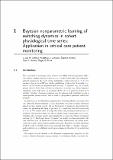Bayesian nonparametric learning of switching dynamics in cohort physiological time series: Application in critical care patient monitoring
Author(s)
Lehman, Li-Wei; Johnson, Matthew James; Nemati, Shamim; Adams, Ryan P.; Mark, Roger G
DownloadAccepted version (849.3Kb)
Terms of use
Metadata
Show full item recordAbstract
Introduction The time series of vital signs, such as heart rate (HR) and blood pressure (BP), can exhibit complex dynamic behaviors as a result of internally and externally induced changes in the state of the underlying control systems (Peng et al. 1995; Ivanov et al. 1999; Costa et al. 2002). For instance, time series of BP can exhibit oscillations on the order of seconds (e.g., due to the variations in sympathovagal balance), to minutes (e.g., as a consequence of fever, blood loss, or behavioral factors), to hours (e.g., due to humoral variations, sleep-wake cycle, or circadian effects) (Mancia 2012; Parati et al. 2013). A question of interest is whether “similar” dynamical patterns can be automatically identified across a heterogeneous patient cohort, and be used for prognosis of patients' health and progress. In this work, we present a Bayesian nonparametric switching Markov processes framework with conditionally linear dynamics to learn phenotypic dynamic behaviors from vital sign time series of a patient cohort, and use the learned dynamics to characterize the changing physiological states of patients for critical-care bed-side monitoring (Lehman et al. 2012, 2013, 2014a; Nemati 2012). We assume that although the underlying dynamical system may be nonlinear and nonstationary and the stochastic noise components can be non-Gaussian, the dynamics can be approximated by a collection of linear dynamical systems (Nemati 2012; Nemati et al. 2012). Each such linear “dynamic” (or mode) is a time-dependent rule that describes how the future state of the system evolves from its current state, centered around a given system equilibrium point. Therefore, an ideal algorithm would be able to identify time series segments that follow a “similar” dynamic, and would switch to a different mode upon a change in the state of the underlying system. We explore several variants of the Bayesian nonparametric approach to discovery of shared dynamics among patients via switching Markov processes: hierarchical Dirichlet process (HDP) autoregressive hidden Markov model (HDP-AR-HMM) (Teh et al. 2006; Fox et al. 2008), an explicit-duration HDP-based hidden semi-Markov model (HDP-AR-HSMM) (Johnson & Willsky 2013a), and the beta process autoregressive HMM (BP-AR-HMM) (Fox 2009; Fox et al. 2009, 2014).
Date issued
2015Department
Massachusetts Institute of Technology. Institute for Medical Engineering & ScienceJournal
Working Paper - Harvard University OpenScholar
Publisher
Cambridge University Press
Citation
Lehman, Li-wei H. et al. “Bayesian nonparametric learning of switching dynamics in cohort physiological time series: Application in critical care patient monitoring.” Working Paper - Harvard University OpenScholar, vol. 344581, 2015 © 2015 The Author(s)
Version: Author's final manuscript